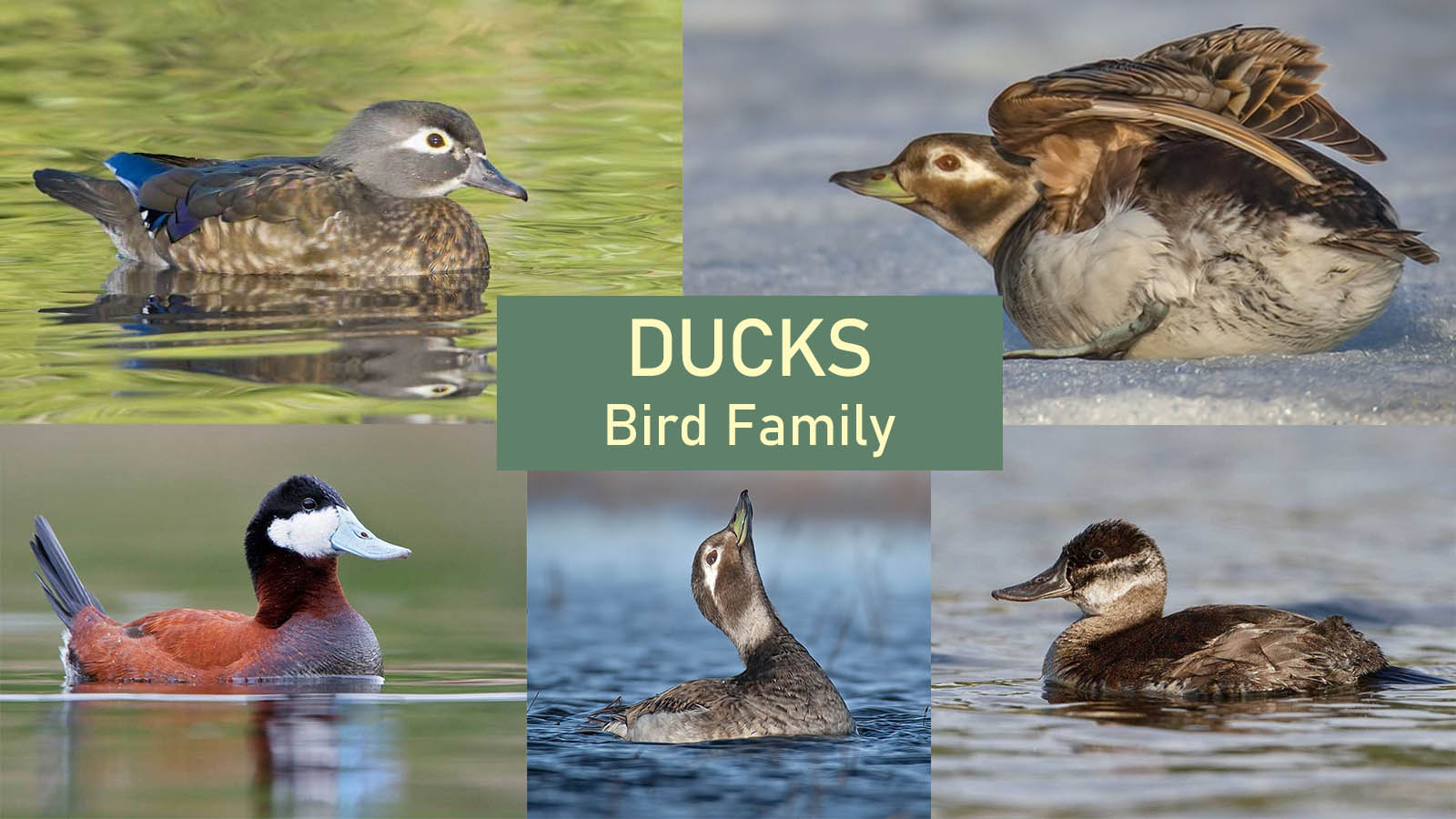
Types of ducks can be difficult to identify, especially if you have a large flock in front of you.
Almost everyone knows what a duck looks like, although not every bird that looks like a duck is a duck. With so many different types of ducks, identification can get really difficult.
Mergansers are duck-like but have a narrow bill adapted for catching fish. Geese generally have longer necks and are larger than most ducks. The American Coot looks like a small black duck, but is more closely related to rails.
The males of most duck species are fairly easy to identify. The females ducks can be confusing.
Ducks molt their flight feathers in the summer, leaving males looking like females. The ducks are flightless during this period, and the birds are referred to as being in their ‘eclipse’ plumage.
On this page
Dabbling or Puddle Ducks
Puddle ducks are types of ducks that obtain their food by rapidly opening and closing their beaks on the surface of shallow water. They also dip their heads below the water surface to pick food, such as aquatic plants, fish, mollusks, and other invertebrates, from the bottom. These duck species usually have big, flat beaks, and live in ponds and shallow wetlands.
Mallard
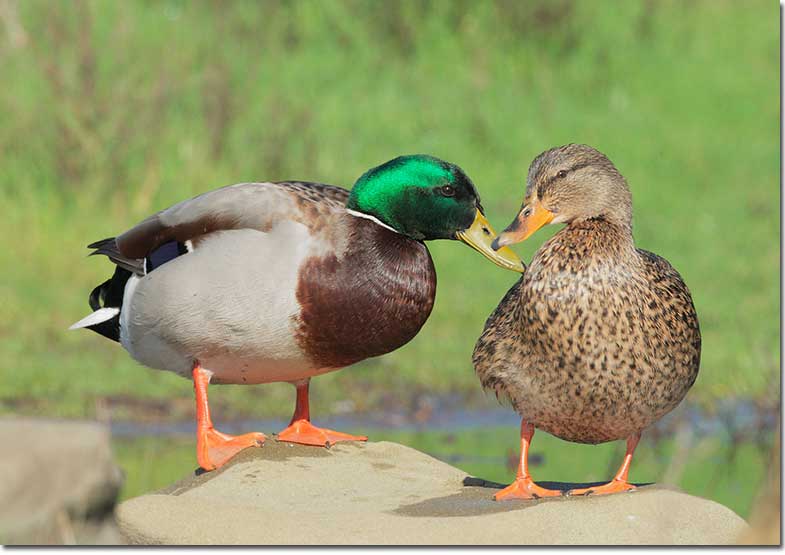
Range: Most parts of North America and northern Eurasia.
Length: 23 inches
Wingspan: 35 inches
Mallards are fairly large, familiar ducks with orange legs and feet. Male Mallards are buff-gray birds with a big, flat yellow beak, dark, glossy green head, narrow white collar, and brown chest. They also have some black on their undertail, a white tail, and a black rump with a small, curled feather.
Female Mallards are mottled brown and buff with a dark cap, dark line through their eyes, and an orange and black beak.
Both sexes have white underwings and a large dark blue wing patch with narrow white borders.
Did you know? Ducks group together for social aspects, as well as protection.
This common duck species lives on ponds, lakes, and many other wetlands.
Mottled Duck
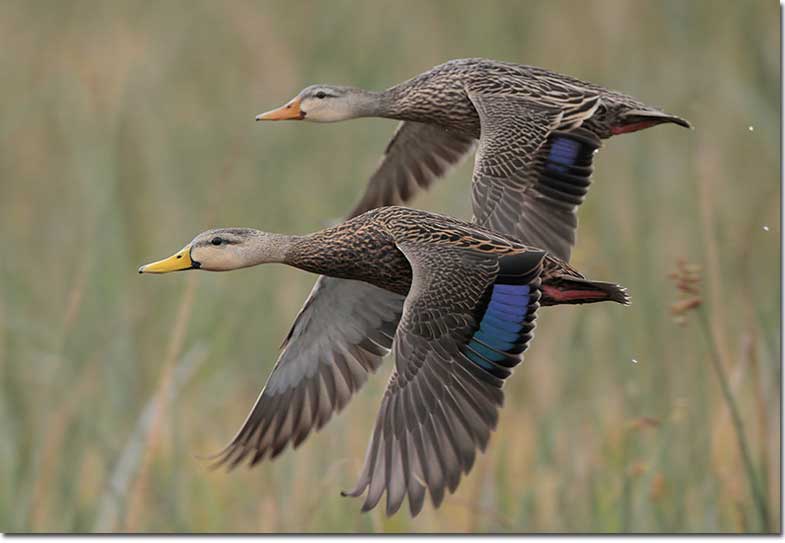
Pair of Mottled Ducks
Range: Florida, Louisiana, Texas, and limited range inland during breeding.
Length: 22 inches
Wingspan: 30 inches
The Mottled Duck is a big dabbling duck with a large yellow or olive-yellow beak. Both sexes are very similar and are mostly dark brown with some pale edging on their feathers. Females tend to show more dark markings on their body feathers than males.
See more: 12 Facts About Ducks That Will Make You Appreciate Them
We can recognize this duck species by its buffy neck and head, and unmarked throat. They also have some dark gray markings on the crown and back of their neck. Male and female Mottled Ducks have a dark line through their eyes, a dark blue patch in their wings, and bright white underwings.
The Mottled Duck lives in coastal marshes and other wetlands.
American Black Duck
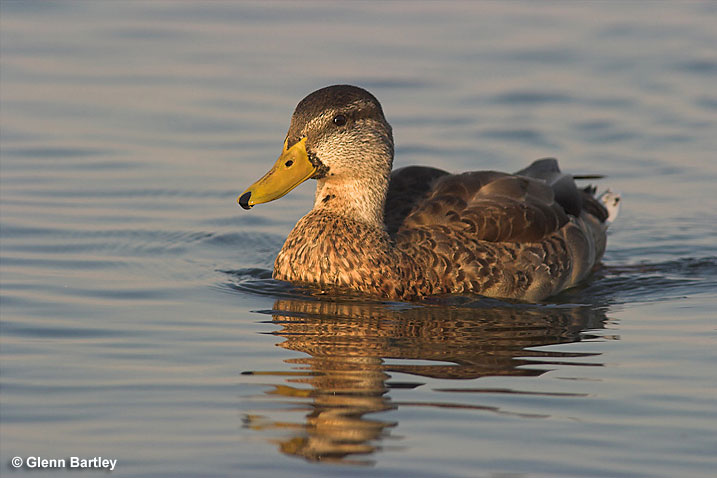
Range: Eastern Canada and the eastern USA, from Wisconsin to Alabama.
Length: 23 inches
Wingspan: 35 inches
The American Black Duck is a big and hefty, dark brown bird with a dingy, flat, yellow-green beak. This duck species has a bit of pale edging to feathers on their body. However, just like their name indicates, other than their paler neck and head, these types of ducks can look blackish.
These dabblers have a dark cap, a dark line through their eyes, and fine, dark streaking on their neck.
Both sexes have orange legs and a dark blue patch on each upperwing. In flight, they also show bright white underwings.
We find American Black Ducks in lakes, ponds, salt marshes, and other wetland habitats.
Gadwall
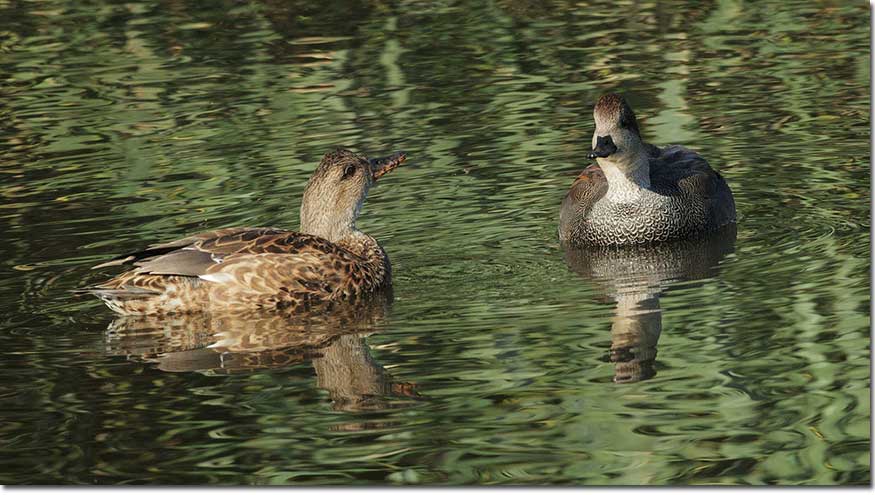
Range: Southern Alaska, much of southern Canada, most of the USA, Mexico, and northern Eurasia.
Length: 28 inches
Wingspan: 33 inches
This duck species is a medium-sized bird with a small white patch on each wing. Male Gadwalls are gray with fine black barring and mottling. They have a paler buff-gray head, rather slight gray beak, cinnamon patch on the shoulders of their wings, and a black rump and undertail.
Related: Best Bird Identification Apps
The female Gadwall is mottled brown and gray with broad buff edging on her body feathers. She also has a fairly thin gray and orange beak. In flight, both sexes show white underwings and a white belly.
We find Gadwalls in marshes, lakes, rivers, ponds, and other shallow wetlands with some emergent vegetation.
Green-winged Teal
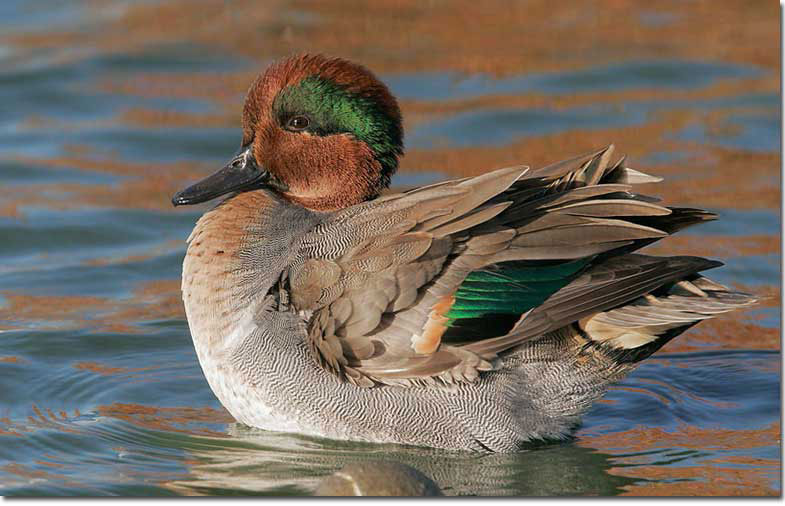
Range: Most of North America (including Alaska), and northern Eurasia.
Length: 14 inches
Wingspan: 23 inches
Green-winged Teals are small dabbling ducks with fairly small, dark beaks, and buff on each side of their undertail. Drakes have a dark, glossy green patch on their chestnut head, and have a chestnut neck, mottled buff chest, and gray back and flanks.
Female Green-winged Teals are dark brown with pale buff edging on most of their feathers. They also have a dark line through their eyes and a dark cap.
In flight, both sexes show some white on their underwings, pale belly, and a dark green patch with buff borders.
This duck species lives in a variety of shallow wetland habitats, including mud flats.
Blue-winged Teal
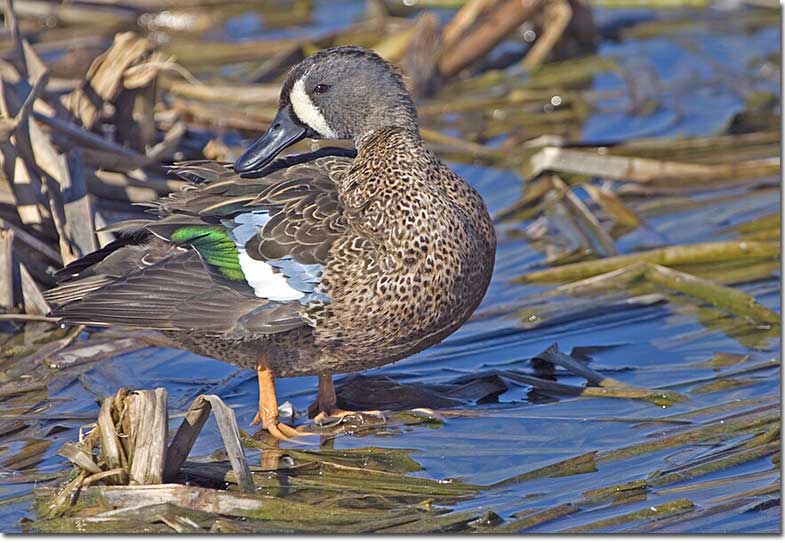
Range: Parts of Alaska, much of Canada, and the lower 48 states south to northern South America.
Length: 15.5 inches
Wingspan: 23 inches
Blue-winged Teals are small ducks with a gray-blue patch on the shoulder of each wing. They also have a fair-sized, dark gray beak. Breeding males have a rich brown body with black mottling, and dark gray head with a white, crescent-shaped mark on their face.
Related: Is bread bad for ducks?
This duck species has a small white patch on the lower part of their flanks and black on their rump, tail, and undertail. Female Blue-winged Teals are mottled brown and gray ducks with pale edging on their feathers. They also have a dark line through their eyes and some pale markings on their face.
This duck species lives in various shallow wetland habitats.
Cinnamon Teal
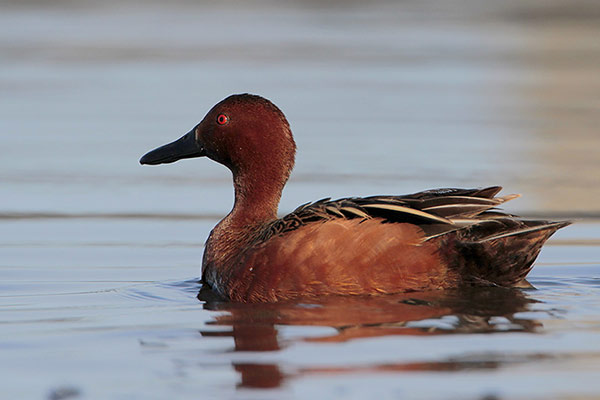
Range: Southwestern Canada, the western USA, Mexico, Central America, and parts of South America.
Length: 16 inches
Wingspan: 22 inches
Cinnamon Teals are rather small ducks with red eyes and fairly big dark beaks. Males are a beautiful, deep reddish-brown with some paler cinnamon feathers on their back. They also have black on their undertail, rump, and slightly pointed tail.
Female Cinnamon Teals are plain, mottled gray and brown ducks with buff edging on most of their feathers. These types of ducks also have a plain, buff face with pale, broken eyering but no lines through their eyes.
In flight, Cinnamon Teals show white on their underwings and pale blue shoulders. We find this duck species in a variety of shallow wetland habitats.
American Wigeon
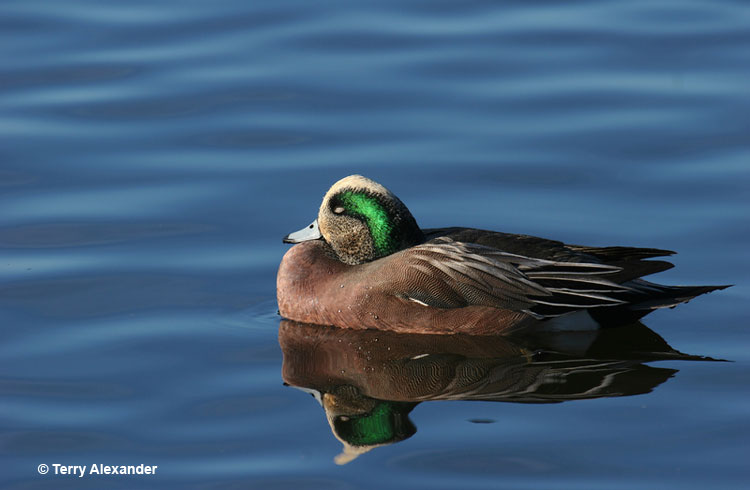
Range: North America (including Alaska) south to Mexico and Central America.
Length: 20 inches
Wingspan: 32 inches
American Wigeons are medium ducks with pointed tails. They also have small, pale blue beaks with a narrow black border.
Males have a dark green mark on their heads, white crown, and mottled pale gray face. They also have a grayish-peach colored body with some black in their wings and on their undertail.
Female American Wigeons are similar but have a plain, mottled grayish head with a dark mark around their eyes. They also have pale edging and mottling above and on their undertail.
In flight, male American Wigeons have white shoulders, but females lack this mark. These types of ducks also have white underwings and occur in a variety of shallow wetland habitats.
Northern Pintail
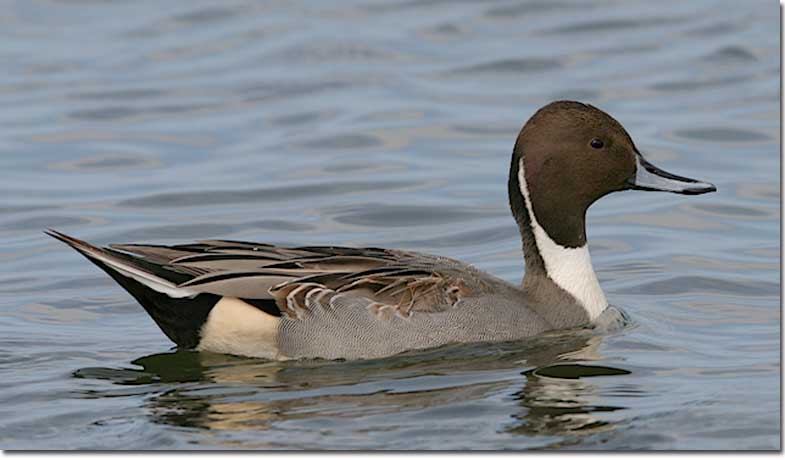
Range: Most of North America (including Alaska) south to Mexico, and northern Eurasia
Length: 21 inches
Wingspan: 34 inches
Northern Pintails are fairly large and slender ducks with long necks, long, pointed tails, and fairly long, pale gray beaks. Males are gray with a white chest, white line in the side of their neck, and a chocolate brown head.
They also have a white belly and lower flanks and black on their rump and undertail. In flight, their wings show a dark green patch with pale borders.
Hens are pale brown and buff birds with a plain, tawny head and pale throat. In flight, their grayish wings have two pale wing bars.
We find this duck species in marshes and other shallow wetlands.
Northern Shoveler
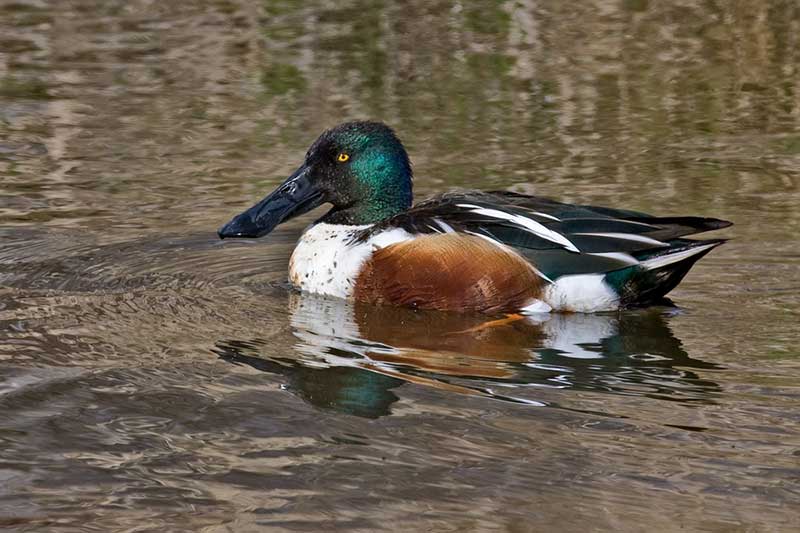
Range: Alaska and much of North America to Central America, and Eurasia.
Length: 19 inches
Wingspan: 30 inches
Northern Shovelers are smallish to medium-sized ducks with extra-large, spatulate bills, white tails, and orange legs. Breeding males have pale eyes, a dark, glossy green head, and a blackish beak. The rest of their body is white and gray with a big chestnut patch on their belly and flanks.
In flight, male Northern Shovelers show a pale blue shoulder and a dark green patch in their wings.
Females are mottled pale brown and gray with buff edging on their feathers. These types of ducks also have an orange and gray beak and lack the male’s blue shoulder patch.
We find this duck species in shallow wetlands.
Diving Ducks
These types of ducks get their food by diving below the surface of lakes, rivers, and coastal waters. They often flock together, and tend to have more rounded bodies and heads than other ducks. We can also recognize diving duck species by their black breasts and undertails, and habit of diving under the water.
Canvasback
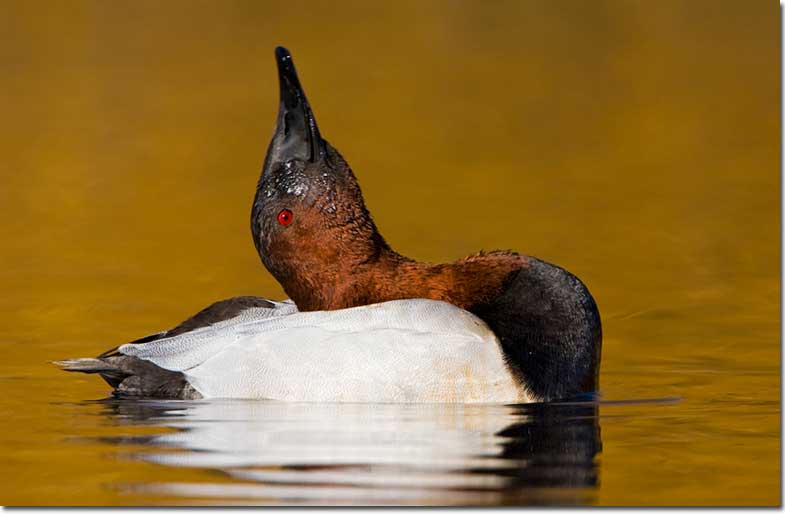
Range: Parts of Alaska, western Canada, and various parts of the USA south to Mexico.
Length: 21 inches
Wingspan: 29 inches
Male Canvasbacks are fair-sized ducks with a deep chestnut head and neck, and red eyes. They also have a long black beak, black chest, and black undertail, tail, and rump. The rest of their plumage is white and pale gray.
Females have a tawny chest and tawny head with paler markings around their eyes. They also have pale brown and gray bodies and a slightly darker tail. In flight, both sexes show plain gray wings with white on their underwings.
This duck species lives in shallow freshwater marshes, lakes, rivers, and shallow coastal bays.
Redhead
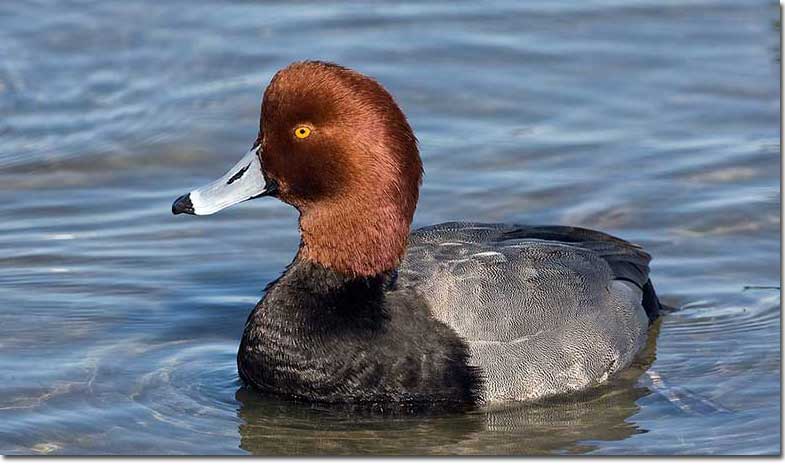
Range: Parts of Alaska and central and western Canada, and many areas in the USA south to Mexico.
Length: 19 inches
Wingspan: 29 inches
The male Redhead is a fair-sized duck with pale eyes and a bright red-brown head. They also have a pale, blue-gray beak with a small black tip, black chest, and dark undertail, rump, and tail. The rest of its body is plain gray.
Female Redheads are fairly uniform, tawny-brown birds with some pale coloring near their eyes and on their throats. In flight, this duck species shows gray wings with paler gray flight feathers. It also has extensive white on its underwings.
We see this duck species in coastal lagoons, marshes, lakes, harbors, and other shallow wetland habitats.
Ring-necked Duck
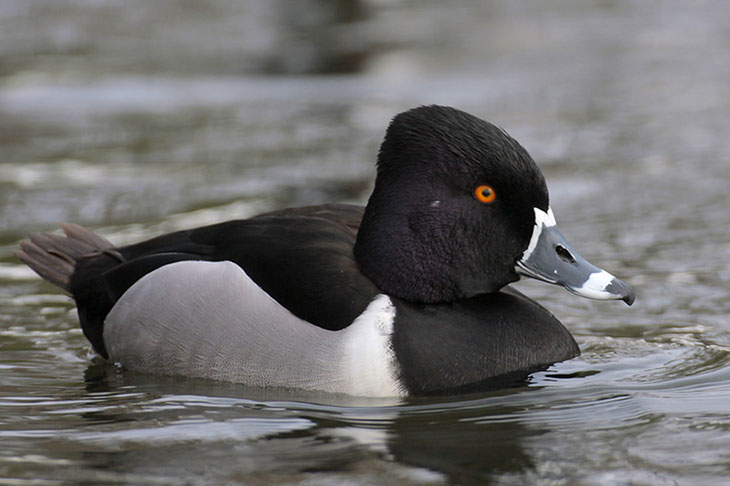
Range: Eastern Alaska, much of Canada, and many parts of the USA south to Central America.
Length: 17 inches
Wingspan: 25 inches
The male Ring-necked Duck is a smallish diving duck with a glossy black, peaked head. It has a black and white tip on its gray beak, black back, and black tail and undertail.
It has an indistinct, dark brown collar, and a broad white mark separating its black chest from its pale gray sides.
Females are gray brown birds with a white belly, and dark brown wings and back. They also have a grayish throat and face, narrow white spectacles, and white near the base of their beak.
In flight, Ring-necked Ducks have uniform gray flight feathers. We find this duck species on lakes, rivers, and other shallow wetlands.
Greater Scaup
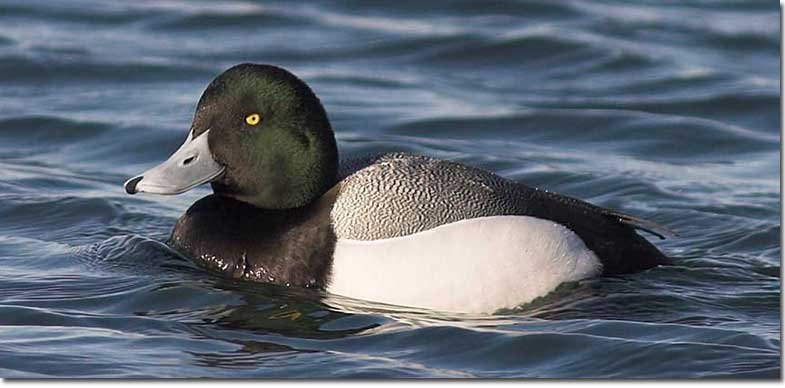
Range: Alaska, northern Canada, the Great Lakes, and coastal waters of Canada and the USA.
Length: 18 inches
Wingspan: 28 inches
Greater Scaup are smallish diving ducks with pale eyes and fairly large, blue-gray beaks. They also have rounded heads that can seem to have a bulging forehead.
Males have blackish heads with a dark, iridescent green gloss. These birds have a pale, mottled gray back, white flanks and belly, and black chest, undertail, tail, and rump.
Female Greater Scaup have a dark brown head and chest and a white patch on their face. They also have brown-gray bodies and a white belly.
In flight, both sexes show a broad white “stripe” on their wings. We find this duck species on large lakes and shallow coastal waters.
Lesser Scaup
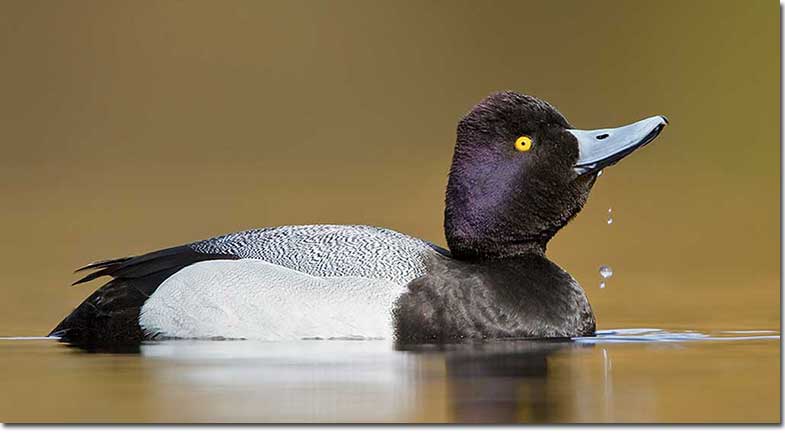
Lesser Scaup male
Range: Alaska, western and central Canada, and large parts of the USA south to Central America.
Length: 16.5 inches
Wingspan: 25 inches
Lesser Scaup are rather small diving ducks with pale, blue-gray beaks. They have pale eyes, and their head often appears to show a peaked crown.
Males have dark heads with glossy green or purple iridescence and a black chest, rump, tail, and undertail. They also have a pale, mottled gray back, some mottling on white flanks, and a white belly.
Female Lesser Scaups are dark brown ducks with a white patch on their face. They have darker plumage on their head and chest.
Keep learning: Comparison of Lesser and Greater Scaup
In flight, this duck species shows a broad white stripe on half of its wing. We find them on reservoirs and small, shallow bodies of water.
Whistling Ducks
Whistling duck species are large ducks with long necks and fairly long legs. These types of ducks can form large, noisy flocks in rice fields and other shallow wetlands. We can recognize them by their longish legs, erect stance, and loud whistling calls.
Black-bellied Whistling Duck
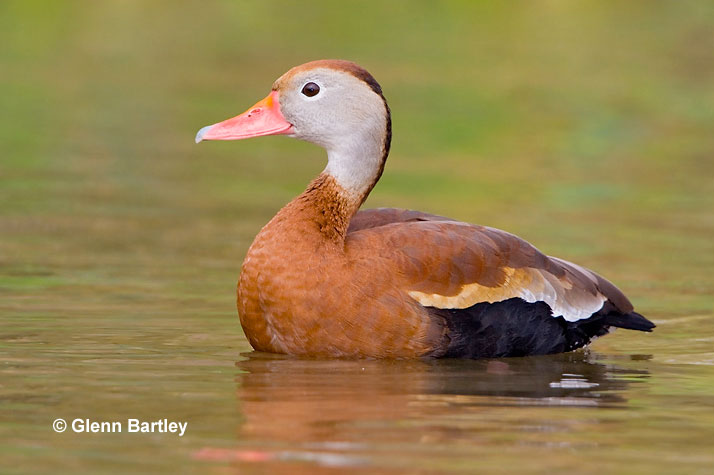
Range: The southeastern USA and southern Arizona south to South America.
Length: 21 inches
Wingspan: 30 inches
Black-bellied Whistling-Ducks are fairly large birds with long necks and long pink or gray legs. Adults have a big, orange-red beak and pale gray face with a small white eyering. The rest of their plumage is tawny brown with black on their belly, undertail, and tail. They also show a bit of white on their closed wings.
Juveniles are more gray-brown and have a gray beak and legs. This duck species flies with deep, slow, goose-like strokes on long, broad wings. Its wings are black underneath and have a broad white stripe above.
This duck species lives in rice fields and other shallow wetlands.
Fulvous Whistling-Duck
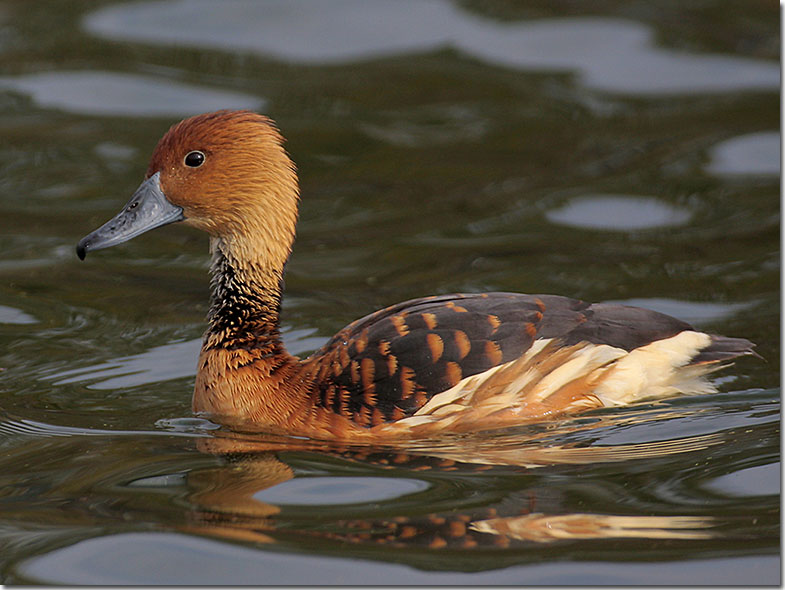
Range: Southern Florida and parts of the southeastern USA, Mexico to South America, the Caribbean, sub-Saharan Africa, and parts of southern Asia.
Length: 19 inches
Wingspan: 26 inches
The Fulvous Whistling-Duck is a fairly large bird with a long neck, long, gray legs, and a big, dark beak. Adults are pale tawny brown with some broad, rusty barring on their dark back.
They also have a dark line through their eyes and some fine gray streaks on their neck. This species has some white markings on its sides, a white undertail, and a short, black and white tail.
Juveniles are like adults but are paler overall and grayer above. In flight, these types of ducks show plain, blackish wings. This duck species lives in rice fields and various types of shallow wetlands.
See more – Whistling Ducks
Perching Ducks
Perching ducks are types of ducks that nest in trees. They also frequently perch in trees and often live in wooded swamps. Unlike other ducks, perching ducks don’t usually occur in big, open bodies of water. This duck species can be recognized by its longish tail, slim appearance, small beak, and other features.
Wood Duck
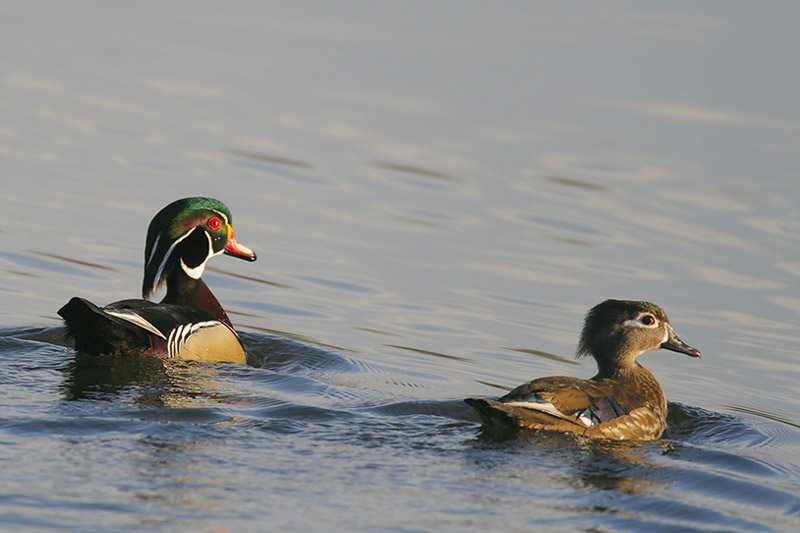
Range: Parts of southern Canada, some areas in the western USA, and all of the eastern USA.
Length: 18.5 inches
Wingspan: 30 inches
The Wood Duck is a smallish, slender duck with a long tail and a unique appearance. Male Wood Ducks have a rounded head with a drooping, glossy green crest, red eyes, black and white face and throat, and fairly stubby, red beak.
This duck species has a chestnut neck separated from straw-yellow flanks by a white line, dark chestnut undertail, and dark green and brown upperparts.
Females are mostly mottled gray-brown with some pale spotting and have a broad white area around their eyes.
In flight, Wood Ducks show a white belly and have fairly uniform dark wings. They mostly live in wooded swamps. Interestingly, they like to nest in tree cavities, which is not something you can expect from ducks.
Sea Ducks
Sea ducks are duck species that spend a fair number of months of each year in marine waters. Although these types of ducks breed in fresh water, they spend most of the year in coastal bays or on reservoirs and other large bodies of water. They can be recognized by their small size, diving habits, and habitat.
Harlequin Duck
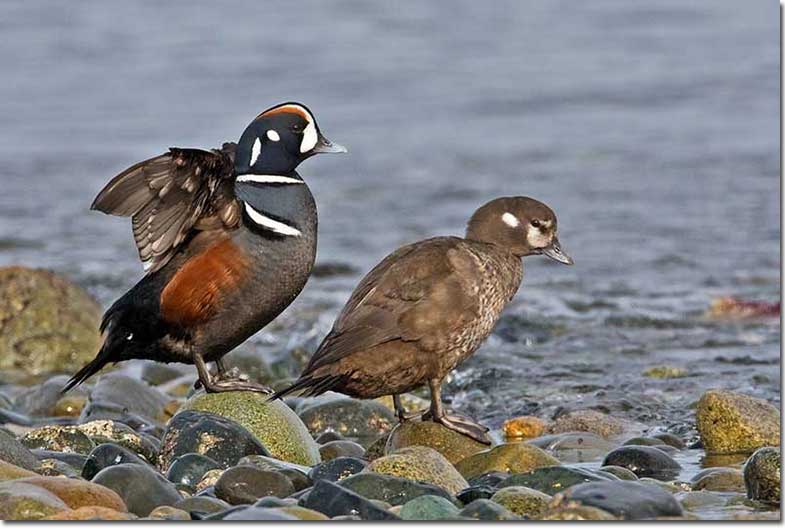
Range: Northeastern Canada, Alaska, western Canada to northern California, and the northeastern coast of the USA. They also live in Iceland, Greenland, and northeastern Asia.
Length: 16.5 inches
Wingspan: 26 inches
The Harlequin Duck is a small, dark bird with a short, gray beak and a long, pointed tail. Males are boldly patterned, dark gray birds with a white, crescent-shaped patch on each side of their face. They also have other seemingly random white markings on their body and chestnut flanks.
Female Harlequin Ducks are dark gray-brown, have a small, round white spot on the side of their head, and some white on the front part of their face. Females also have a white belly.
Both sexes have mostly dark wings in flight. We find this duck species in rough coastal waters near jetties and on cold, rushing rivers.
Common Goldeneye
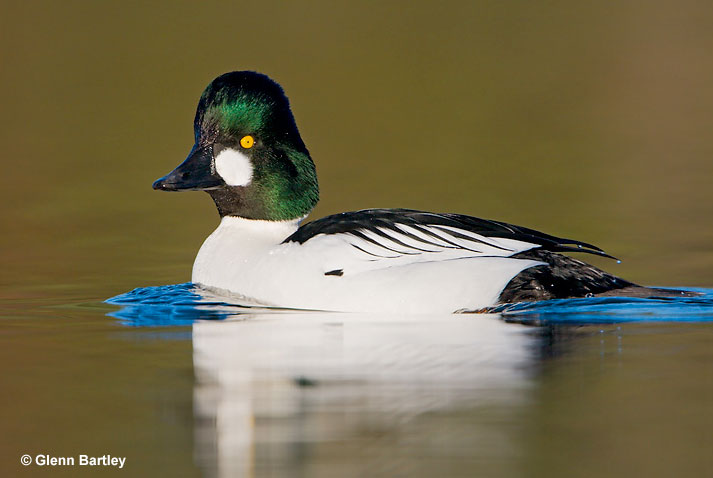
Range: Alaska, a large part of Canada, most of the USA, and northern Eurasia.
Length: 18.5 inches
Wingspan: 26 inches
Common Goldeneyes are small sea ducks with fairly big, peaked heads, pale yellow eyes, and large dark beaks. Males are white with black on their back, tail, undertail, and wings. They also have a glossy green-black head with a large white spot on the front of their face.
Females are mostly brown-gray and have a dark brown head, a pale collar, and a white belly. In flight, both sexes of the Common Goldeneye show big white patches in their wings.
We find this common duck species on large lakes, big rivers, reservoirs, and in bays and other sheltered coastal waters.
Bufflehead
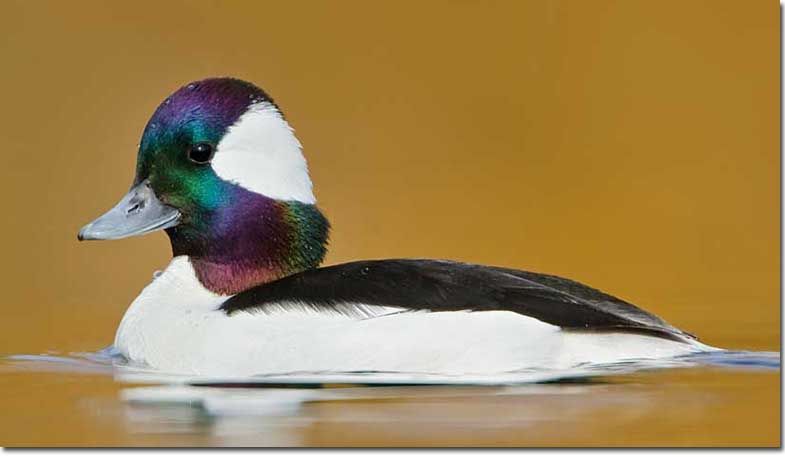
Range: Alaska, a large part of Canada, and most of the USA south to Mexico.
Length: 13.5 inches
Wingspan: 21 inches
The Bufflehead is a small, black and white sea duck with a fairly small gray beak and a somewhat pointed tail. Males are white with a black and white back and wings. They also have a big white patch on their glossy, purplish-black head.
Females are brown-gray and have a white patch on the side of their heads. In flight, females also show a white belly and a small white patch on each wing. Males have much larger white patches on their wings.
We can find these ducks on northern lakes but mostly see them on reservoirs, large rivers, lakes, and shallow coastal waters.
Eiders
Eiders are large types of ducks that mostly breed in far northern regions and winter in cold marine waters.
We can recognize these big, heavy ducks by their black and white markings, and square-shaped, ornate heads. Eiders usually form flocks that migrate by flying in long lines, low over the water.
Common Eider
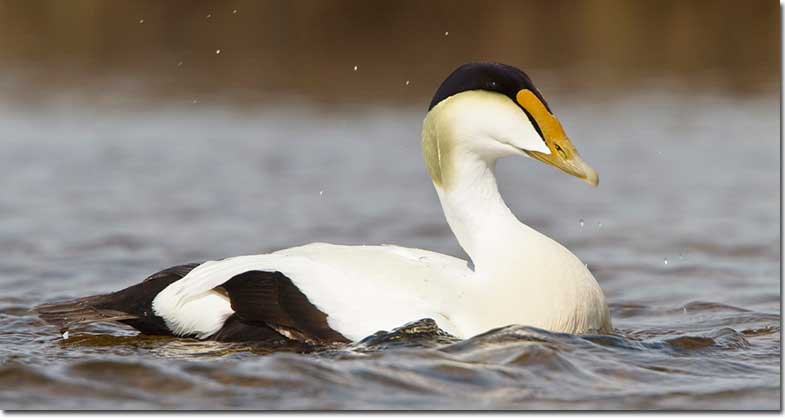
Range: Coastal areas of Alaska, Canada, the northeastern USA, Greenland, Iceland, and parts of northern Eurasia.
Length: 24 inches
Wingspan: 38 inches
Common Eiders are big ducks with long, sloped foreheads and beaks. Males are white with a black cap, belly, flanks, undertail, tail, and rump. They also have a yellowish or greenish beak, and a sea-green patch on the back of their neck. Young and winter males are mostly black-brown with some white.
Females are mottled gray-brown or red-brown with pale edging on their feathers, have a narrow dark line going back from their eyes, and dark gray beaks.
In flight, male Common Eiders show black and white wings while females have mostly plain wings with a bit of white.
This duck species frequents cold coastal waters.
King Eider
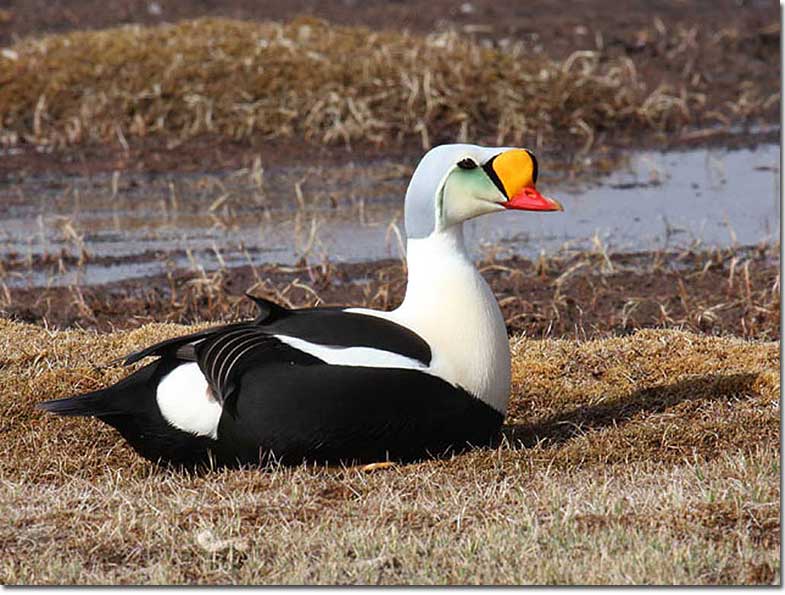
King Eider male
Range: Arctic and coastal regions of Alaska, Canada, the northeastern USA, Greenland, Iceland, and parts of northern Eurasia.
Length: 22 inches
Wingspan: 35 inches
The King Eider is a fairly large and stocky duck with a blocky, square-shaped head. Breeding male King Eiders have gray, white, and orange heads with a stout red beak. They also have a buff wash on their white chest, a black and white body, and black and white wings.
Nonbreeding and young male King Eiders are mostly dark brown with some white and have orange beaks. Female King Eiders are mottled buff and brown birds with a pale line going back from their eyes.
This duck species occurs in cold coastal waters, often further north than the Common Eider.
Mergansers
Mergansers are large ducks with long, slender beaks, long bodies, and rounded or crested heads. These highly aquatic waterfowl species frequently dive to catch fish and crustaceans underwater. These types of ducks are fast-flying birds that winter in coastal regions and other bodies of water.
Common Merganser
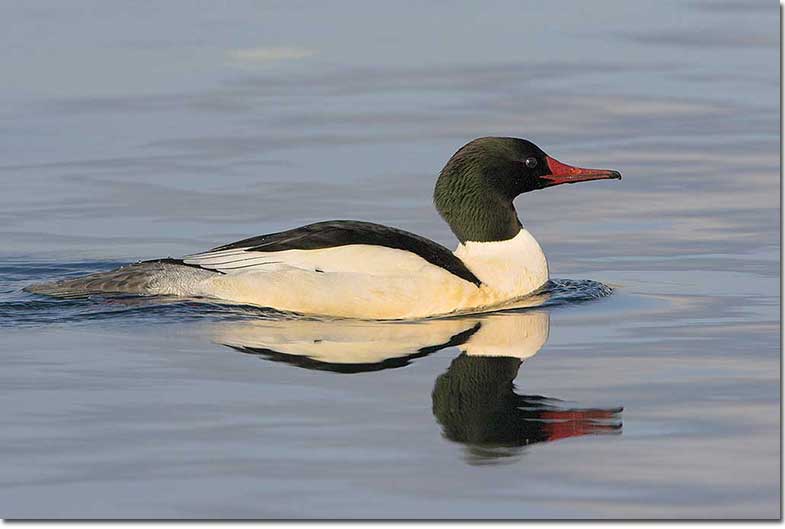
Range: Parts of Alaska, much of Canada, and the northern and western parts of the USA. They also occur in Eurasia.
Length: 25 inches
Wingspan: 34 inches
The Common Merganser is a big duck species with a low profile and a long, pointed orange beak. They also have orange legs and a slightly wedge-shaped gray tail.
Males of this duck species are white with a glossy black-green head and have black and white on their wings and back. Female and nonbreeding male Common Mergansers are gray with a white belly and a brown head. They also have a small white throat patch and a hint of a crest.
Common Mergansers have a direct flight with powerful wing beats. When flying, they show large white wing patches.
This duck species lives on cold rivers, lakes, reservoirs, and shallow coastal waters.
Red-breasted Merganser
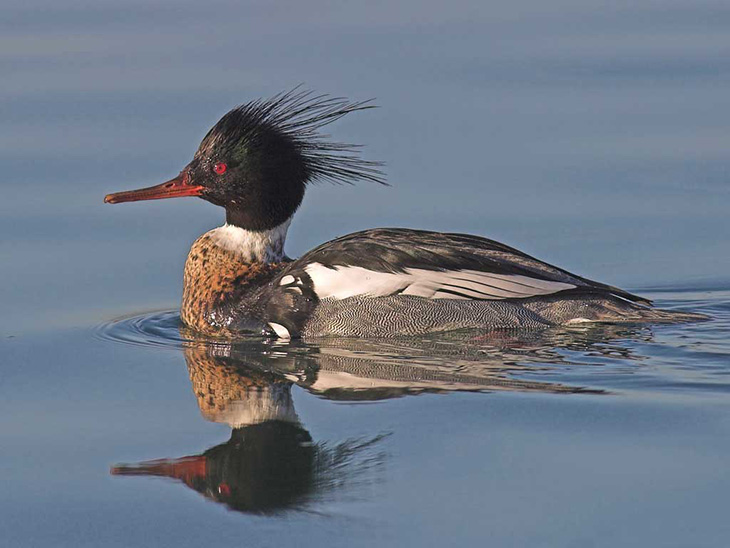
Range: Alaska, Canada, The Great Lakes, coastal areas south to Mexico and the Caribbean, and Eurasia.
Length: 23 inches
Wingspan: 30 inches
Red-breasted Mergansers are fairly large, slender, highly aquatic ducks with a shaggy “double crest” and a long, thin red-orange beak. Breeding males have a glossy dark green head, broad white collar, and a mottled, dark brown chest.
They also have black and white spotting on their upper flanks, gray sides, a white belly, and black and white wings. Female Red-breasted Mergansers and nonbreeding males have gray bodies, white bellies, and a tawny head and neck.
These types of ducks have a bit of white on their throat and around their eyes. This duck species flocks together in shallow coastal waters and on large lakes.
Hooded Merganser
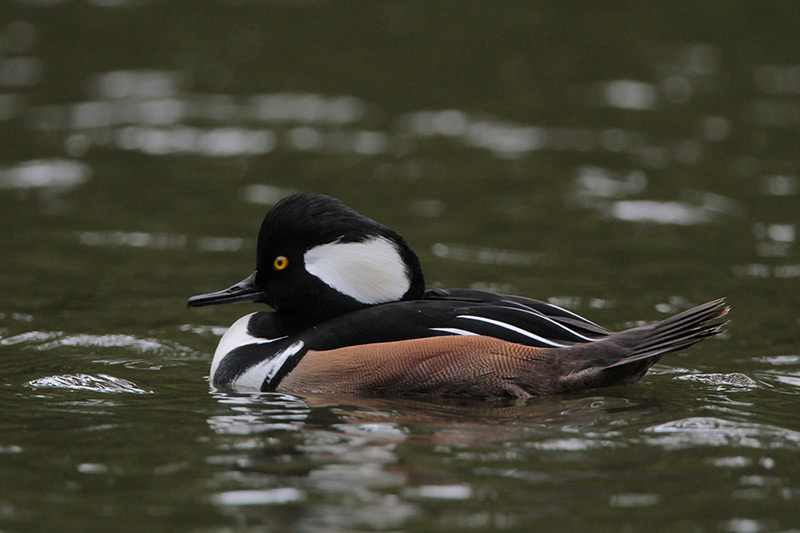
Photograph © Greg Lavaty.
Range: Much of southern Canada, the eastern USA, and coastal habitats in the western USA.
Length: 18 inches
Wingspan: 24 inches
The Hooded Merganser is a small duck species with a slender, pointed beak, longish tail, and a rounded head. Breeding males have a bold, black and white head, black neck, white chest, and two black marks on their upper sides.
They also have a black back with a few wispy white feathers, black tail and undertail, and pumpkin-orange flanks.
Female and nonbreeding male Hooded Mergansers are brown-gray with a tawny-brown crest, and have a white belly.
In flight, this duck species has a smallish white patch on narrow, pointed wings. We see it in wooded swamps and shallow wetland habitats.
Stiff-tailed Ducks
Stiff-tailed ducks are small duck species with pointed tails. These types of ducks also have fairly large heads with gray or blue beaks, and rather short wings. We can recognize stiff-tailed ducks by their habit of holding their pointed tails cocked up as they float on ponds and lakes. They dive below the water to feed.
Ruddy Duck
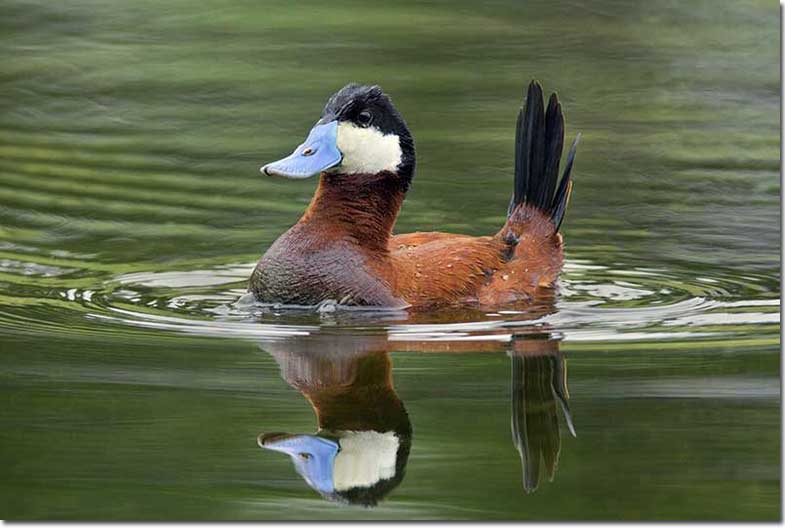
Male Ruddy Duck in breeding plumage
Range: Central and southern Canada, and many parts of the USA south to Mexico.
Length: 15 inches
Wingspan: 18.5 inches
The Ruddy Duck is a small duck with a black cap on its large head. It also has longish, wedge-shaped tail feathers and a large pale blue or dark gray beak.
Male Ruddy Ducks have rich, chestnut-colored plumage and a prominent white throat and face. In non-breeding plumage, males have the same plumage pattern but are brown-gray instead of chestnut.
Females of this duck species resemble nonbreeding males, but they have a dark line on their pale faces. In flight, both sexes of the Ruddy Duck have dark upperwings, mottled white on their underwings, and a pale belly.
This duck species lives in a variety of shallow wetland habitats.

